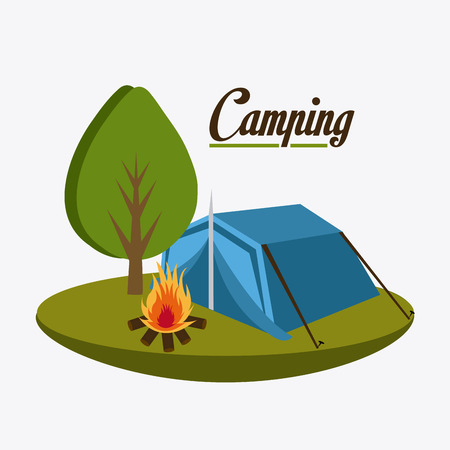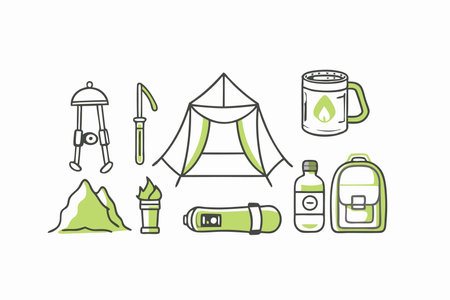Overview: State Parks vs. National Parks
If you’re looking to pitch your tent or park your RV in America’s great outdoors, you’ll have two main options: state parks and national parks. While both offer unforgettable camping experiences, they have some key differences that can impact your trip. State parks are managed by individual state governments, while national parks are run by the federal National Park Service. This management difference affects not only the rules and regulations but also funding and maintenance priorities. Generally, national parks are larger and protect massive, iconic landscapes—think Yellowstone or Yosemite—while state parks tend to be more localized gems, often highlighting unique features of a specific region. Funding for national parks comes from federal budgets and entrance fees, which can translate into higher quality infrastructure but also bigger crowds and stricter reservation systems. State parks rely heavily on state funding and may feel less crowded or commercialized but sometimes come with fewer amenities. Understanding these distinctions is crucial when deciding where to camp for your next outdoor adventure.
2. Camping Experience: What to Expect
When it comes to camping, the choice between state parks and national parks can seriously shape your outdoor adventure. Both offer incredible ways to connect with nature, but the vibe, amenities, and overall experience can be very different. Let’s break down what you can expect in terms of comfort, style, and solitude at each.
Amenities: Comforts and Conveniences
| Amenity | State Parks | National Parks |
|---|---|---|
| Restrooms & Showers | Usually well-maintained facilities; many have hot showers | Basic or rustic restrooms; showers less common |
| Campsite Utilities (Electric/Water) | Often available at RV/tent sites; hook-ups common | Rarely provided; most sites are primitive or dry camping |
| Picnic Tables & Fire Rings | Standard at most campsites | Available but sometimes limited depending on location |
| Camp Stores & Rentals | Many state parks have small stores or rental gear onsite | Limited availability; might need to bring everything with you |
| Cell Service/WiFi | More likely to have coverage near urban areas | Sparse or non-existent in remote locations |
Camping Styles: From Car Camping to Backcountry Adventures
State Parks: If you’re looking for classic car camping, family-friendly sites, or easy access for RVs and trailers, state parks have you covered. They tend to be more developed and cater to campers who want a few home comforts while still sleeping under the stars.
National Parks: For those craving wilderness immersion, national parks often offer more primitive campsites. Think hike-in tent spots, backcountry permits, and minimal infrastructure—perfect if you want to really disconnect and rough it for a while.
Solitude: Finding Your Own Slice of Wilderness
The level of solitude can be a dealbreaker for many campers. National parks attract millions every year—especially the famous ones like Yosemite or Yellowstone—so expect crowds during peak season. State parks, on the other hand, often fly under the radar. You’ll find fewer people, quieter campgrounds, and better chances to score that secluded site by a lake or deep in the woods. For those seeking peace and quiet, state parks can feel like hidden gems compared to their bustling national counterparts.

3. Accessibility and Reservations
When it comes to camping in the U.S., getting your hands on a good campsite can be as competitive as scoring tickets to a playoff game. National Parks are iconic and massively popular—think Yellowstone, Yosemite, or the Grand Canyon. Because of their fame, these parks often have reservation systems that open months in advance and sell out within minutes, especially for peak season weekends. Many National Park campgrounds require you to plan far ahead or get lucky with a first-come, first-served spot, which can mean showing up at sunrise and hoping for the best. This high demand leads to crowded campgrounds and busy trails, especially during summer and holidays.
State Parks, on the other hand, tend to fly under the radar. While some top-tier state parks fill up fast, most offer more flexibility when it comes to snagging a campsite. Reservation windows are typically shorter—sometimes just a few months ahead—and its usually easier to find last-minute openings. State park campgrounds are often less crowded and feel more laid-back, making them ideal for spontaneous trips or families who want space to spread out. Plus, many state parks offer online reservation systems that are user-friendly and straightforward, so you can lock down your spot without jumping through hoops.
If you crave solitude or dont like fighting crowds for a patch of dirt, state parks might be your best bet. But if youre determined to check off those bucket-list locations in national parks, make sure youre ready to act fast when reservations drop—or be prepared for some competition at the gate.
4. Costs and Permits
When you’re planning a camping adventure, your budget matters as much as your backpack weight. State parks and national parks in the U.S. have different fee structures and permit requirements, so it’s smart to know what you’re paying for before you roll out your sleeping bag.
Camping Fees and Entrance Costs
| State Parks | National Parks | |
|---|---|---|
| Entrance Fees | Usually $5–$10 per vehicle; some parks free | Typically $20–$35 per vehicle; annual passes available ($80 America the Beautiful Pass) |
| Camping Fees | $15–$40 per night (varies by amenities and location) | $20–$30 per night (standard sites); backcountry often requires additional permits |
| Discounts | Resident discounts in many states; senior or military rates common | Interagency passes, senior, access, military discounts accepted |
Permit Requirements: What You Need to Know
State Parks: Most state parks only require a reservation for campsites—especially during peak season. Some popular parks may need day-use permits or parking passes. If you’re planning to hike into remote areas or go off-grid, check if a special wilderness permit is needed.
National Parks: The big leagues of outdoor adventure come with stricter rules. Many national parks require advance reservations for campgrounds, especially in summer. Backcountry camping almost always needs a permit, which can be limited and competitive (think lottery systems for Yosemite or Grand Canyon). Some activities—like fishing, boating, or climbing—may also require specific permits.
Pro Tips for Outdoor Adventurers
- Book Early: Both park types fill up fast—reservations open months ahead.
- Check for Hidden Fees: Look out for vehicle fees, extra-person charges, firewood restrictions, or day-use add-ons.
- Always Double-Check Rules: Each park has unique policies; check their official websites before heading out.
The Bottom Line on Budgeting Your Trip
If you want the classic American wilderness experience without breaking the bank, state parks often offer cheaper entry points and more flexible booking. National parks deliver bucket-list scenery but expect to pay more and plan further ahead—especially if you’re after those legendary backcountry spots. Either way, knowing the costs and permit requirements upfront keeps your adventure on track—and your wallet happy.
5. Nature and Adventure Opportunities
When it comes to outdoor adventure, both state parks and national parks deliver—but the type and scale of your experience can differ dramatically. If you’re an adrenaline junkie or a wilderness purist, knowing what each park system brings to the table can make or break your next camping trip.
Hiking Trails: From Laid-Back Loops to Epic Treks
National parks are famous for their iconic hikes—think summiting Half Dome in Yosemite or tackling the Angel’s Landing trail in Zion. These trails are often longer, more challenging, and offer dramatic landscapes you won’t find anywhere else. State parks, on the other hand, usually offer shorter, less crowded trails that still showcase local beauty. They’re perfect for families or anyone looking to squeeze in a hike without committing an entire day.
Wildlife Encounters: Big Game vs. Local Favorites
If spotting wildlife is on your bucket list, national parks give you front-row seats to America’s most legendary creatures—bison in Yellowstone, grizzlies in Glacier, or elk in Rocky Mountain National Park. State parks might not have grizzlies roaming around, but they do offer plenty of chances to see deer, foxes, birds of prey, and smaller mammals up close. Plus, with fewer crowds, your odds of a quiet wildlife encounter go way up.
Survival Challenges: Testing Your Outdoor Skills
For campers who thrive on self-reliance and rugged conditions, national parks can present legit survival challenges—remote backcountry zones, unpredictable weather, and serious navigation tests. You’ll need solid skills (and maybe a bit of grit) to thrive here. State parks are generally more accessible and user-friendly but still provide opportunities for bushcraft practice or honing your fire-starting game—just with a safety net closer at hand.
Bottom line: Whether you crave raw adventure or just want to dip your toes into the wild, both state and national parks deliver unique nature experiences for every type of camper. Choose your battleground wisely!
6. Best Picks: Choosing the Right Park for Your Trip
If you’re staring at your map and wondering whether a state park or national park is the right fit for your next camping adventure, it all comes down to what you want out of the trip—and when you plan to go. Here’s how to zero in on the perfect spot, using a practical, boots-on-the-ground approach.
When to Pick a State Park
State parks are often less crowded, more affordable, and offer that local flavor and accessibility many campers crave. If your main goal is to escape the crowds, enjoy spontaneous getaways, or introduce family and friends to camping without complicated logistics, state parks are usually the way to go. They’re also clutch for shoulder-season trips—think early spring or late fall—when national parks may still be snowed in or require advanced reservations. Planning a quick weekend adventure? State parks are typically closer to home and easier to book last minute.
Top Reasons:
- You want budget-friendly camping
- You prefer quieter campgrounds
- You need flexible dates or same-day bookings
- You love exploring hidden local gems
When National Parks Win Out
National parks are icons for a reason. If your trip is all about bucket-list landscapes, epic hiking trails, or wildlife encounters you can’t find anywhere else, it’s worth planning ahead and braving the crowds. Go for national parks if you’re seeking classic American wilderness experiences—think Yellowstone geysers or Yosemite granite walls—or if you’re aiming for that once-in-a-lifetime adventure with friends or family. Summer is prime time but be ready for high demand; book months in advance if possible.
Top Reasons:
- You’re chasing legendary scenery and big adventures
- You want top-tier ranger programs and visitor centers
- Your group is up for longer drives and more planning
- You’re checking off America’s “must-see” natural wonders
Seasonal Smarts: Timing Is Everything
For summer trips, state parks can save your sanity when national parks are jam-packed. In winter, southern state parks offer mild weather while some national parks become snow lover’s paradises. Spring and fall are prime times to nab a spot in either system with fewer crowds—just check conditions before heading out.
The Bottom Line:
If you want easy access, affordability, and solitude, put state parks at the top of your list. If you’re after iconic vistas and don’t mind planning ahead, aim for a national park experience. Match your destination to your goals—and never underestimate what’s waiting in your own backyard.


